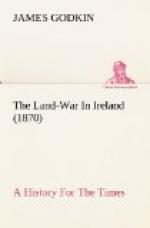[Footnote 1: The Cromwellian Settlement, p.163, &c.]
The Restoration at length brought relief and enlargement to the imprisoned Irish nation. They rushed across the Shannon to see their old homes; they returned to the desolated cities, full of hope that the king for whom they had suffered so much would reward their loyalty, by giving them back their inheritances—the ’just satisfaction’ promised at Breda to those who had been unfairly deprived of their estates. The Ulster Presbyterians also counted on his gratitude for their devotion to his cause, notwithstanding the wrongs inflicted on them by Strafford and the bishops in the name of his father. But they were equally doomed to disappointment. Coote and Broghill reigned in Dublin Castle as lords justices. The first parliament assembled in Dublin for twenty years, contained an overwhelming majority of undertakers, adventurers, and Puritan representatives of boroughs, from which all the Catholic electors had been excluded. ‘The Protestant interest,’ a phrase of tremendous potency in the subsequent history of Ireland, counted 198 members against 64 Catholics in the Commons, and in the Lords 72 against 21 peers. A court was established under an act of parliament in Dublin, to try the claims of ‘nocent’ and ‘innocent’ proprietors. The judges, who were Englishmen, declared in their first session that 168 were innocent to 19 nocent. The Protestant interest was alarmed; and, through the influence of Ormond, then lord lieutenant, the duration of the court was limited, and when it was compelled to close its labours, only 800 out of 3,000 cases had been decided. If the proportions of nocent and innocent were the same, an immense number of innocent persons were deprived of their property. In 1675, fifteen years after the Restoration, the English settlers were in possession of 4,500,000 acres, while the old owners retained 2,250,000 acres. By an act passed in 1665, it was declared that no Papist, who had not already been adjudged innocent, should ever be entitled to claim any lands or settlements.’
Any movement on the part of the Roman Catholics during this reign, and indeed, ever since, always raised an alarm of the ’Protestant interest’ in danger. While the panic lasted the Catholics were subjected to cruel restrictions and privations. Thus Ormond, by proclamation, prohibited Catholics from entering the castle of Dublin, or any other fortress; from holding fairs or markets within the walls of fortified towns, and from carrying arms to such places. By another proclamation, he ordered all the relatives of known ‘tories’ to be arrested and banished the kingdom, within fourteen days, unless such tories were killed or surrendered within that time. There was one tory for whose arrest all ordinary means failed. This was the celebrated Redmond O’Hanlon, still one of the most popular heroes with the Irish peasantry. He was known on the continent as Count O’Hanlon,




